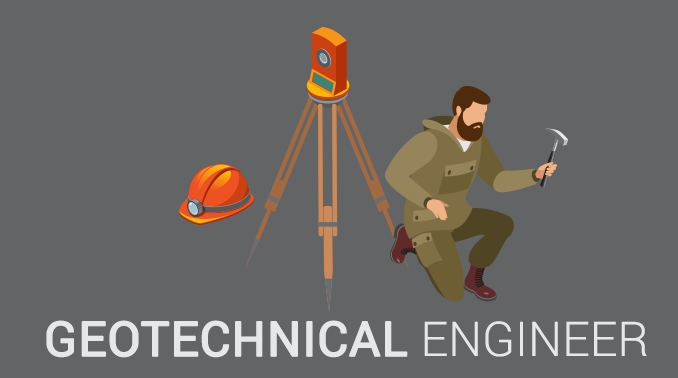The Best Strategy To Use For Geotheta
Wiki Article
7 Easy Facts About Geotheta Described
Table of ContentsAll about GeothetaA Biased View of GeothetaExamine This Report on GeothetaThe Ultimate Guide To Geotheta9 Easy Facts About Geotheta Shown

They perform site investigations, gather samples, carry out lab examinations, and analyze data to assess the suitability of the ground for building and construction projects - Geo Tech Engineering. Based upon their findings, geotechnical engineers offer suggestions for foundation style, incline security, retaining structures, and reduction of geotechnical threats. They work together with various other specialists, such as engineers, structural designers, and building and construction groups, to make certain that geotechnical factors to consider are integrated into the overall job style and implementation
By evaluating the behavior and residential properties of soil and rock, they can determine possible geotechnical threats such as landslides, soil negotiation, or incline instability. Their expertise aids avoid failures or accidents that can threaten lives and property. Right here are some thorough responsibilities and responsibilities of a geotechnical engineer: Website Examination: Geotechnical engineers conduct site examinations to collect data on subsurface problems.
They translate the data to recognize the buildings and behavior of the soil and rock, including their strength, permeability, compaction qualities, and groundwater conditions. Geotechnical Evaluation and Design: Geotechnical engineers examine the data gathered throughout website examinations to evaluate the security and viability of the website for building tasks. They execute geotechnical estimations and modeling to review elements such as birthing capability, settlement, slope security, lateral planet stress, and groundwater circulation.
The Best Strategy To Use For Geotheta
Foundation Design: Geotechnical engineers play a crucial duty in developing foundations that can safely support the intended framework. They examine the dirt problems and load needs to figure out the proper foundation kind, such as shallow foundations (e.g., grounds), deep structures (e.g (https://telegra.ph/Why-Geotheta-is-Your-Go-To-for-Geotechnical-Engineers-in-South-Africa-08-02)., piles), or specialized strategies like dirt renovation. They take into consideration variables such as negotiation limitations, bearing capacity, and soil-structure communication to establish ideal foundation stylesThey evaluate building plans, screen site tasks, and perform field evaluations to verify that the layout referrals are adhered to. If unexpected geotechnical problems develop, they assess the scenario and provide suggestions for remediation or changes to the style. Threat Assessment and Mitigation: Geotechnical designers examine geotechnical risks and threats linked with the job site, such as landslides, liquefaction, or soil erosion.

Collaboration and Interaction: Geotechnical designers work very closely with other professionals included in a project, such as designers, structural designers, and building teams. Reliable communication and collaboration are necessary to incorporate geotechnical considerations right into the total task layout and construction process. Geotechnical engineers give technical experience, response queries, and make sure that geotechnical requirements are fulfilled.
See This Report about Geotheta
Below are some sorts of geotechnical engineers: Foundation Designer: Structure engineers focus on creating and evaluating structures for structures. They assess the soil problems, lots requirements, and site features to establish the most suitable structure kind Geo Tech Engineer and design, such as shallow foundations, deep foundations, or specialized methods like heap foundations.They assess the elements affecting slope security, such as dirt buildings, groundwater conditions, and slope geometry, and create strategies to stop incline failures and alleviate threats. Quake Designer: Quake designers focus on assessing and designing frameworks to endure seismic forces. They evaluate the seismic risk of a site, assess soil liquefaction potential, and create seismic design criteria to guarantee the safety and durability of frameworks throughout quakes.
They carry out area testing, collect examples, and assess the accumulated information to define the soil properties, geologic developments, and groundwater conditions at a website. Geotechnical Instrumentation Engineer: Geotechnical instrumentation engineers concentrate on tracking and measuring the behavior of dirt, rock, and structures. They install and keep instrumentation systems that keep track of elements such as dirt settlement, groundwater degrees, incline motions, and structural variations to examine performance and supply early warnings of prospective concerns.
Geotheta - Truths
They perform tests such as triaxial examinations, loan consolidation tests, straight shear examinations, and leaks in the structure examinations to gather information for geotechnical analysis and layout. Geosynthetics Engineer: Geosynthetics designers concentrate on the style and application of geosynthetic materials, such as geotextiles, geogrids, and geomembranes. They utilize these products to improve soil stability, enhance slopes, supply water drainage options, and control disintegration.They have a tendency to be investigative individuals, which indicates they're intellectual, introspective, and investigative. They are interested, systematic, rational, analytical, and sensible. Some of them are additionally social, meaning they're kind, charitable, participating, individual, caring, helpful, empathetic, sensible, and friendly - Consulting Engineers.
In the office environment, geotechnical designers make use of specialized software application devices to do calculations, produce designs, and evaluate data. They prepare reports, evaluation job specifications, communicate with clients and employee, and coordinate task activities. The workplace setting gives a favorable setting for research study, analysis, and cooperation with various other specialists included in the task.
Some Known Details About Geotheta
They regularly go to task sites to perform site examinations, assess geotechnical conditions, and gather information for analysis. These visits include taking a trip to different places, sometimes in remote or challenging terrains. Geotechnical designers may do soil sampling, conduct examinations, and monitor building tasks to guarantee that the geotechnical facets of the project are being carried out correctly.Geotechnical engineers additionally work in specialized geotechnical labs. In these centers, they conduct experiments, perform tests on dirt and rock examples, and evaluate the design residential properties of the products. Geotechnical laboratory designers function thoroughly in these environments, dealing with screening tools, operating instruments, and taping data. They work together with various other research laboratory team to guarantee precise and dependable testing outcomes.
Report this wiki page